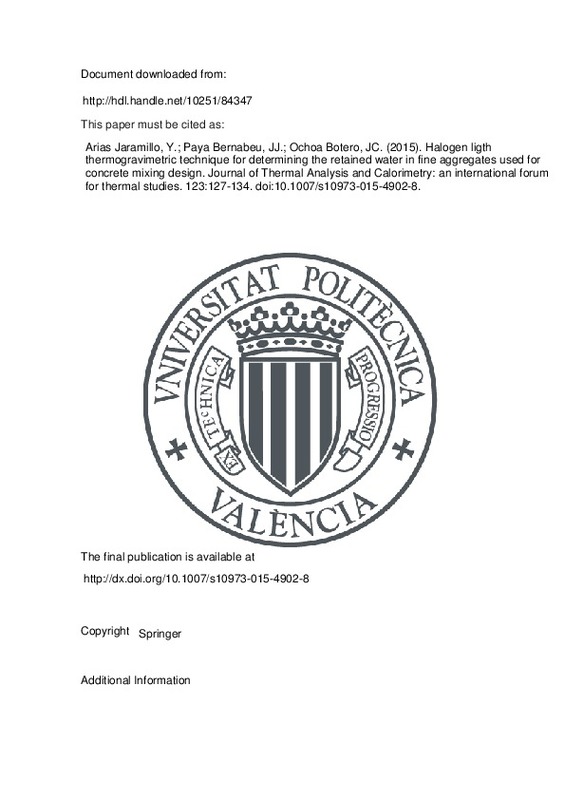JavaScript is disabled for your browser. Some features of this site may not work without it.
Buscar en RiuNet
Listar
Mi cuenta
Estadísticas
Ayuda RiuNet
Admin. UPV
Halogen ligth thermogravimetric technique for determining the retained water in fine aggregates used for concrete mixing design
Mostrar el registro sencillo del ítem
Ficheros en el ítem
| dc.contributor.author | Arias Jaramillo, Y.P.
|
es_ES |
| dc.contributor.author | Paya Bernabeu, Jorge Juan
|
es_ES |
| dc.contributor.author | Ochoa Botero, Juan Carlos
|
es_ES |
| dc.date.accessioned | 2017-07-03T12:04:22Z | |
| dc.date.available | 2017-07-03T12:04:22Z | |
| dc.date.issued | 2015 | |
| dc.identifier.issn | 1388-6150 | |
| dc.identifier.uri | http://hdl.handle.net/10251/84347 | |
| dc.description.abstract | [EN] Measuring the rate of water retention of the aggregates used in mortars and concrete is required to achieve a good mix design. The water retention, specifically absorption, is used to keep constant the water/cement ratio. This paper focuses on the study of a new technique for measuring retained water in fine aggregates. In order to obtain results, the procedure described in the existing standards takes more than 24 h. Additionally, it involves high consumption of heat energy due to the use of drying ovens. Furthermore, the results obtained remain highly variable and therefore discussed by the scientific community.In this research, a novel technique based on a halogen moisture analyzer was implemented. The technique was assessed using an experiment design with a surface response model. The most important factors and levels were identified together with the interactions between them. Finally, the model was validated and the results obtained with this technique were compared with those obtained by conventional techniques in order to verify that they were equivalent. | es_ES |
| dc.language | Inglés | es_ES |
| dc.publisher | Springer | es_ES |
| dc.relation.ispartof | Journal of Thermal Analysis and Calorimetry: an international forum for thermal studies | es_ES |
| dc.rights | Reserva de todos los derechos | es_ES |
| dc.subject | Fine aggregate | es_ES |
| dc.subject | Absorbed water | es_ES |
| dc.subject | Adsorbed water | es_ES |
| dc.subject | Concrete Mortar | es_ES |
| dc.subject | TG | es_ES |
| dc.subject.classification | INGENIERIA DE LA CONSTRUCCION | es_ES |
| dc.title | Halogen ligth thermogravimetric technique for determining the retained water in fine aggregates used for concrete mixing design | es_ES |
| dc.type | Artículo | es_ES |
| dc.identifier.doi | 10.1007/s10973-015-4902-8 | |
| dc.rights.accessRights | Abierto | es_ES |
| dc.contributor.affiliation | Universitat Politècnica de València. Escuela Técnica Superior de Ingenieros de Caminos, Canales y Puertos - Escola Tècnica Superior d'Enginyers de Camins, Canals i Ports | es_ES |
| dc.description.bibliographicCitation | Arias Jaramillo, Y.; Paya Bernabeu, JJ.; Ochoa Botero, JC. (2015). Halogen ligth thermogravimetric technique for determining the retained water in fine aggregates used for concrete mixing design. Journal of Thermal Analysis and Calorimetry: an international forum for thermal studies. 123:127-134. doi:10.1007/s10973-015-4902-8 | es_ES |
| dc.description.accrualMethod | S | es_ES |
| dc.relation.publisherversion | http://dx.doi.org/10.1007/s10973-015-4902-8 | es_ES |
| dc.description.upvformatpinicio | 127 | es_ES |
| dc.description.upvformatpfin | 134 | es_ES |
| dc.type.version | info:eu-repo/semantics/publishedVersion | es_ES |
| dc.description.volume | 123 | es_ES |
| dc.relation.senia | 325902 | es_ES |
| dc.identifier.eissn | 1572-8943 | |
| dc.description.references | Djerbi Tegguer A. Determining the water absorption of recycled aggregates utilizing hydrostatic weighing approach. Constr Build Mater. 2012;27:112–6. | es_ES |
| dc.description.references | Kasemchaisiri R, Tangtermsirikul S. A method to determine water retainability of porous fine aggregate for design and quality control of fresh concrete. Constr Build Mater. 2007;21:1322–34. | es_ES |
| dc.description.references | Gonilho Pereira C, Castro-Gomes J, Pereira de Oliveira L. Influence of natural coarse aggregate size, mineralogy and water content on the permeability of structural concrete. Constr Build Mater. 2009;23:602–8. | es_ES |
| dc.description.references | Cortas R, Roiziére E, Staquet S, Hamami A, Delplancke-Ogletree M. Effect of the water saturation of aggregates on the shrinkage induced cracking risk of concrete at early age. Cem Concr Compos. 2014;50:1–9. | es_ES |
| dc.description.references | Black R. The determination of specific gravity using Siphon-Can method. Cem Concr Aggreg. 1986;8:46–50. | es_ES |
| dc.description.references | Saxer E. A direct method of determining absorption and specific gravity of aggregates. 1956;2. | es_ES |
| dc.description.references | Hughes B, Famili H., Part 1—Absorption of concrete aggregates, Part 2—saturated air techniques for determining the absorption of aggregates. In: Absorptions of concrete aggregates. Birmingham University; 1971. | es_ES |
| dc.description.references | Tam VWY, Gao XF, Tam CM, Chan CH. New approach in measuring water absorption of recycled aggregates. Constr Build Mater. 2008;22:364–9. | es_ES |
| dc.description.references | Balcedowiak W. Phase analysis of high-calcium line by TG. J Therm Anal Calorim. 2000;60:70–7. | es_ES |
| dc.description.references | Mendoza O, Tobón JI. An alternative thermal method for identification of pozzolanic activity in Ca(OH)2/pozzolan pastes. J Therm Anal Calorim. 2013;114:589–96. | es_ES |
| dc.description.references | Kosmatka SH, Kerkhoff B, Panarese W, MacLeod NF, McGrath RJ, Design and control of concrete mixtures. 7rd ed. Cement association of Canada. 2002. pp. 88. | es_ES |
| dc.description.references | Cárdenas JI, Restrepo C. Patrimonio geológico y patrimonio minero de la cuenca carbonífera del suroeste antioqueño, Colombia. Boletín de ciencias de la tierra. 2006;18:91–102 ISSN 0120-3630 . | es_ES |
| dc.description.references | Klein NS, Aguado A, Tollares-Carbonari BM, Real LV. Prediction of the water absorption by aggregates over time: modelling through the use of value function and experimental validation. Constr Build Mater. 2014;69:213–20. | es_ES |







![[Cerrado]](/themes/UPV/images/candado.png)

